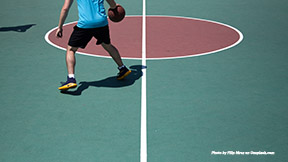In the Game of Life, Recognize the Race and Sprint to Win
What are your chances of winning a race if you don’t realize you’re in one? It’s a profound question, and one worth asking after watching a high school basketball game where one team seemed completely unaware they were competing. They didn’t lose because of a lack of talent but because they failed to recognize the urgency of the moment.
This isn’t just a basketball problem. It’s a life problem. Recognizing that you’re in a race and adopting a Sprint Mentality can be the difference between success and falling behind.
The Human Race: A Call to Action
Have you ever thought about why we’re called the human race? The term suggests urgency and motion. Yet, many people don’t realize they’re in the race at all. The starting gun fires, your competition takes off, and you’re left standing, unaware or unprepared. By the time you decide to move, the gap is too great.
In basketball, this looks like teams failing to transition from defense to offense with purpose. They jog up the court, pass the ball around aimlessly, and settle for poor shots. Meanwhile, their opponents sprint, attack, and score. The difference? Awareness and urgency.
Adopting a Sprint Mentality means recognizing that life’s race has started and committing to run with purpose.
Sprint Mentality: Recognizing Sprint Moments
Life, like basketball, isn’t a continuous sprint. But there are critical moments when you need to shift gears and move with everything you’ve got. In basketball, these moments often revolve around changes in possession:
- Defensive rebounds: Are you pushing the ball upcourt immediately?
- Steals: Are you attacking the basket before the defense can react?
- Turnovers: Are you capitalizing on mistakes to create scoring opportunities?
In life, sprint moments might look like this:
- Job opportunities: Being ready to seize a career-changing chance before others.
- Personal growth challenges: Tackling a tough project or committing to a new habit with urgency.
- Relationships: Acting quickly to express love, forgiveness, or support when it matters most.
Recognizing these moments and acting with urgency is at the heart of the Sprint Mentality.
Life Is a Relay Race
Another way to frame life is as a relay race. You’re not running alone. Whether it’s your family, coworkers, or friends, your actions affect others. The baton gets passed, and each runner’s effort impacts the team’s success.
Here’s the twist: You don’t know if you’re the first runner, the anchor, or somewhere in between. Your job is to run your leg of the race as fast and as well as you can. Jogging through your stretch doesn’t just hurt you—it hurts the team.
Adopting the Sprint Mentality means giving your all, regardless of your position. When the baton is in your hand, the race is yours to win.
How to Develop a Sprint Mentality
What separates winners from those who fall short? It’s not just talent or preparation. It’s the mindset to sprint when it matters most. Here’s how to cultivate it:
1. Practice Urgency

In your daily life, setting small, time-sensitive goals can be transformative. These goals don’t have to be monumental; even completing minor tasks within a specific timeframe helps build the habit of urgency. For instance, set a timer for tasks such as responding to emails, completing a workout, or finishing a chapter of a book. By practicing urgency in the mundane, you prepare yourself for the moments when quick action is critical.
This mindset translates into larger opportunities in life. When a significant project or opportunity arises, the habit of urgency allows you to act decisively and efficiently. You’ll no longer hesitate, waiting for perfect conditions or overanalyzing every detail. Instead, you’ll confidently take the first step, knowing that momentum often creates its own success. Practicing urgency isn’t just about speed; it’s about building trust in your ability to respond effectively when it matters most.
Here is a link to a time management / productivity resource:
2. Visualize Key Moments

Visualization is a powerful tool for developing a Sprint Mentality. Taking time to imagine yourself in key scenarios—whether it’s delivering a crucial presentation, making a game-winning shot, or nailing an important interview—can prepare your mind for success.
This process isn’t just daydreaming; it’s a focused exercise in mental rehearsal. Close your eyes, take deep breaths, and walk yourself through every detail: the environment, your actions, and the outcome you desire. This practice helps your brain feel familiar with high-pressure situations before they even happen.
The more you visualize, the more confident and prepared you become. Athletes often use visualization to imagine themselves excelling under pressure, and the same principle applies to any area of life. Whether you’re facing a boardroom or a basketball court, visualization sharpens your ability to act with precision and poise when the time comes. It’s about mentally rehearsing success so that, when the moment arrives, you’re ready to sprint.
Here is a link to a video on visualization:
3. Prepare for Transitions

Transitions are inevitable, both in life and on the court. Preparing for these shifts ensures that you’re ready to respond with agility and purpose. This preparation involves conditioning—both physically and mentally.
Staying physically fit and healthy gives you the energy and stamina to handle fast-paced transitions, whether that’s chasing a loose ball or seizing a sudden career opportunity. Similarly, maintaining mental sharpness through activities like meditation, problem-solving, and lifelong learning keeps you adaptable in the face of change.
Preparation also means having a plan for the unexpected. Life’s transitions often come without warning, but being proactive can make all the difference. Develop contingency plans, practice adaptability, and remind yourself that change is an opportunity for growth. When you prepare for transitions, you’re not just reacting to the moment—you’re anticipating it, ready to sprint forward while others are still hesitating.
4. Adopt a Winner’s Mindset

Adopting a winner’s mindset means viewing every situation as an opportunity to excel. It’s about cultivating a belief that success is possible, even in challenging circumstances.
Winners focus on solutions, not obstacles. They embrace setbacks as learning experiences and use them to refine their approach. This mindset requires intentional effort—reading motivational books, surrounding yourself with positive influences, and reflecting on your own growth.
Winners also understand the power of consistency. They know that success isn’t always about grand gestures but about showing up, putting in the effort, and sprinting when the moment demands it. By adopting this mindset, you’ll start to see challenges as stepping stones rather than roadblocks. When you approach life with the confidence and determination of a winner, you’re better equipped to sprint toward your goals and achieve lasting success.
Examples of Sprint Moments
Let’s consider some real-world applications of the Sprint Mentality:
- In Business: Imagine a client request comes in at the last minute. The team that acts quickly to deliver quality results gains a competitive edge.
- In Sports: A player who consistently pushes the pace during transitions forces opponents to scramble, creating scoring opportunities.
- In Personal Life: A person who immediately pursues a newfound passion often gets further than someone who waits for the “perfect time.”
Sprint moments are everywhere. The challenge is to recognize them and respond with urgency.
The Payoff of Sprinting
Why is the Sprint Mentality so powerful?
Because most people don’t have it. They wait, hesitate, and miss opportunities. By sprinting when it matters, you gain a massive advantage—in basketball, business, and life.
Teams that embrace the Sprint Mentality dominate transitions. They rebound and push the ball before the defense sets up. They capitalize on turnovers. They’re relentless, always moving forward.
In life, individuals with the Sprint Mentality seize opportunities, respond to challenges, and achieve more in less time. They understand that success isn’t about pacing yourself—it’s about knowing when to sprint.
Closing Thoughts on The Sprint Mentality
The Sprint Mentality isn’t about running all the time. It’s about recognizing when to shift gears and giving everything you’ve got in those crucial moments.
The next time you’re on the court, at work, or facing a personal challenge, ask yourself: Am I running the race? Then run.
When it’s time to sprint, don’t hold back. That’s how you win.
Did you enjoy this article about “The Sprint Mentality”? If so, be sure to leave us a comment. You may also want to check out this article about “Speed“…
click here.









